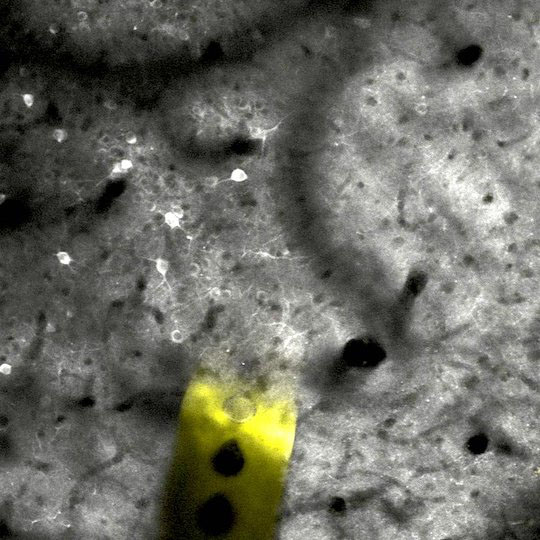| May 30, 2023 |
Flexible nanoelectrodes can provide fine-grained brain stimulation
(Nanowerk News) Conventional implantable medical devices designed for brain stimulation are often too rigid and bulky for what is one of the body’s softest and most delicate tissues.
|
|
To address the problem, Rice University engineers have developed minimally invasive, ultraflexible nanoelectrodes that could serve as an implanted platform for administering long-term, high-resolution stimulation therapy.
|
|
According to a study published in Cell Reports ("Low-threshold, high-resolution, chronically stable intracortical microstimulation by ultraflexible electrodes"), the tiny implantable devices formed stable, long-lasting and seamless tissue-electrode interfaces with minimal scarring or degradation in rodents. The devices delivered electrical pulses that match neuronal signaling patterns and amplitudes more closely than stimuli from conventional intracortical electrodes.
|
 |
| Two-photon microscopy image of a nanoelectrode (yellow) after two months implanted within the brain of a mouse, with healthy active neurons (bright regions) neighboring the implant. (Image: Rice Neuroengineering Initiative, Rice University)
|
|
The devices’ high biocompatibility and precise spatiotemporal stimulus control could enable the development of new brain stimulation therapies such as neuronal prostheses for patients with impaired sensory or motor functions.
|
|
“This paper uses imaging, behavioral and histological techniques to show how these tissue-integrated electrodes improve the efficacy of stimulation,” said Lan Luan, an assistant professor of electrical and computer engineering and a corresponding author on the study. “Our electrode delivers tiny electrical pulses to excite neural activity in a very controllable manner.
|
|
“We were able to reduce the current necessary to elicit neuronal activation by more than an order of magnitude. Pulses can be as subtle as a couple hundred microseconds in duration and one or two microamps in amplitude.”
|
|
The new electrode design developed by researchers in the Rice Neuroengineering Initiative represents a significant improvement over conventional implantable electrodes used to treat conditions such as Parkinson’s disease, epilepsy and obsessive-compulsive disorder, which can cause adverse tissue responses and unintended changes in neural activity.
|
|
“Conventional electrodes are very invasive,” said Chong Xie, an associate professor of electrical and computer engineering and a corresponding author of the study. “They recruit thousands or even millions of neurons at a time.
|
|
“Each of those neurons is supposed to have their own tune and coordinate in a specific pattern. But when you shock them all at the same time, you’re basically disrupting their function. In some cases that works fine for you and has the desired therapeutic effect. But if, for example, you want to encode sensory information, you need much greater control over the stimuli.”
|
|
Xie likened stimulation via conventional electrodes with the disruptive effect of “blowing an airhorn in everyone’s ear or having a loudspeaker blaring” in a roomful of people.
|
|
“We used to have this very big loudspeaker, and now everyone has an earpiece,” he said.
|
|
The ability to adjust the frequency, duration and intensity of the signals could enable the development of novel sensory prosthetic devices.
|
|
“Neuron activation is more diffuse if you use a larger current,” Luan said. “We were able to reduce the current and showed that we have a much more focused activation. This can translate to higher-resolution stimulation devices.”
|
|
Luan and Xie are core members of the Rice Neuroengineering Initiative and their labs are also collaborating on the development of an implantable visual prosthetic device for blind patients.
|
|
“Envision one day being able to implant electrode arrays to restore impaired sensory function: The more focused and deliberate is the activation of the neurons, the more precise the sensation you’re generating,” Luan said.
|
|
An earlier iteration of the devices was used to record brain activity.
|
|
“We have had a series of publications (Nature Biomedical Engineering, "Ultraflexible electrode arrays for months-long high-density electrophysiological mapping of thousands of neurons in rodents") showing this intimate tissue integration enabled by our electrode’s ultraflexible design really improves our ability to record brain activity for longer durations and with better signal-to-noise ratios,” said Luan, who has been promoted to associate professor effective July 1.
|

